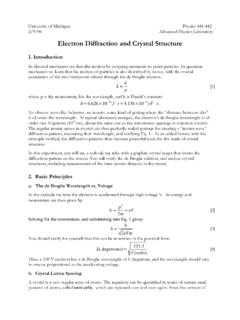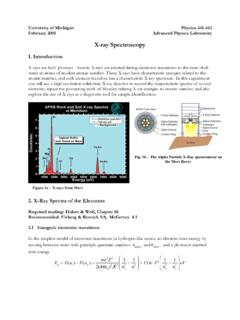Transcription of The Franck-Hertz Experiment - University of Michigan
1 1/30/06 1 The Franck-Hertz Experiment The Franck-Hertz Experiment , first undertaken shortly after Bohr s theory of the atom was pre-sented, provided one of the early indications that atoms had discrete energy levels. In this ex-periment, electrons are accelerated and pass through mercury vapor , where they lose energy by inelastic scattering in quantized steps as they excite mercury atoms from the ground state to an excited state. This elegant Experiment yielded remarkable results that were key in the early de-velopments of quantum theory. Introduction In the Franck-Hertz Experiment , an electron beam is produced by thermionic emission from a filament. The electrons are accelerated, pass through the vapor , and are then retarded (deceler-ated) by a few volts before collection at the anode.
2 This all takes place in a tube contained within an oven that controls the tube s temperature and thus the mercury vapor density. The setup is illustrated schematically in Figure 1, and pictorially in Figure 2. Consider first what happens as the filament is heated, thus raising the average energy of conduc-tion electrons in the metal. As the temperature increases, a greater fraction of the electrons have kinetic energy exceeding the work function of the cathode material (platinum), WPt. Some of these even reach the anode and a small current ( , nanoamps) flows. When the accelerating voltage Va is increased from zero, filament electrons are accelerated toward the grid and a much greater current reaches the anode.
3 If Vg=0, some of the emitted electrons reach the anode and the electron current is registered. The path of current in this circuit passes through the two power supplies, the filament, the mercury vapor in the tube, and through the ammeter. Not all the elec-trons make it to the anode: the beam really isn t a beam, and the trajectories spread out over a large range of angles. The planar geometry does improve the situation. As the accelerating volt-age increases, the anode current increases because the electron trajectories are more focused, and the electrons are deflected less by scattering from the atoms of vapor in the tube. The anode cur-rent is observed to rise faster than linearly with Va.
4 We now take into account electron collisions with the mercury atoms in the vapor . Elastic scat-tering is one channel that results in deflection of the electrons from their original trajectory. In an elastic scattering, the atom recoils in its ground state like a hard sphere, so the electron loses 1/30/06 2 very little energy. Inelastic scattering is also possible. In this process, kinetic energy is lost to excitation or ionization of mercury atoms. The excitation energy is Eex!5 eV, so when (eVa!WPt)<Eex, no such excitation is possible. For electron kinetic energy greater than Eex, it is, in principle, possible for the inelastic process to occur and decrease the electron kinetic energy by about Eex for each mercury atom an electron excites.
5 The scattering process is best represented by a cross section ! the effective area of a mercury atom presented to the electrons as they move through a vapor . Imagine looking through the va-por with total thickness t and a number density n atoms/cm3 from the perspective of an electron with some initial trajectory. The vapor may look partly transparent with an areal density of nt atom/cm2 in the electron s path. The total fraction of that area taken up by mercury atoms from which the electron can scatter is !nt, a measure of the probability the electron will scatter while propagating through the vapor . In the questions, we ask you to estimate ! geometrically and find t1/2, the thickness of vapor that would scatter electrons with 50% probability.
6 The cross section is an effective area and depends on the nature of the interaction, initial energy, final en-ergy and direction, and other quantum mechanical features of the process. The elastic and ine-lastic cross sections are generally quite different: the inelastic excitation cross section can be a resonant process with a relatively large cross section. As an electron passes through the vapor , it gains energy in the accelerating field produced by Va. At the point where the electron s energy exceeds Eex, inelastic scattering becomes possible, and the electron scatters with a short scattering length and loses almost all of its kinetic energy so that the process begins again. Thus multiple inelastic scatterings are possible as an electron moves from cathode to grid.
7 The final energy of electrons that reach the grid is the initial energy, eVa, minus energy lost in scatterings. A small retarding voltage between the grid and anode deflects electrons with energy less than eVg+WCu, where WCu is the work function of the anode. This energy is a few eV. Electrons with greater energy reach the anode and the electron current is registered by the amme-ter. For electrons that lose total energy !E by scattering, the requirement for detection (reach-ing the anode) is !E<eVa"Vg"!W(), where !W, the contact potential , is the difference of work functions of the cathode and anode. The anode current is therefore a measure of the inte-gral number of electrons that satisfy this inequality.
8 These raw data must be analyzed to deter-mine the electron energy loss spectrum and extract Eex. Reading Scattering and cross section are covered in Marion s Classical Mechanics text. The Franck-Hertz Experiment is described in detail in Melissinos I, pp. 8-17. 1/30/06 3 The Apparatus The Franck-Hertz tube is contained within an oven, which is a metal box with a thermostatically controlled heater and terminals for connections to the tube. A thermometer can be inserted through a hole in the top of the oven. The tube has a parallel system of electrodes in order to produce a fairly uniform electric field. The distance between the filament/cathode and the perforated grid is much larger than the mean free path of electrons through the mercury vapor under normal operating conditions.
9 A platinum ribbon with a small barium-oxide spot serves as a direct heated cathode. An electrode connected with the cathode limits the current and suppresses secondary and reflected electrons, making the electric field more uniform. In order to avoid current leakage along the hot glass wall of the tube, a protective ceramic ring is fused in the glass as a feed-through to the counter electrode. The tube is evacuated and coated inside with a getter which absorbs traces of air that leaked in during the manufacturing process and over the lifetime of the tube. Power supplies are provided for the accelerating and grid voltages, and a separate supply is pro-vided for the filament current. The anode current should be read with either a Keithley model 610 Electrometer or a picoammeter.
10 Other voltages should be monitored with DVMs. Before making any connections, be sure you understand the circuit. To aid in understanding, trace the closed circuit that electrons take from the cathodes through the power supplies and elec-trometer and back to the cathode. (Also see the first question.) Take care in making the connections that the signal cable is grounded correctly. The virtual ground represents the effective electrical potential of the ammeter in the circuit. The ammeter has a low impedance, and all the anode current flows through it. You ll discover that the apparatus seems very sensitive to your presence! This is because the small currents detected represent very small amounts of charge flowing, amounts of charge that can be significantly affected by stray capacitance including your own, which is about 100 pf.












